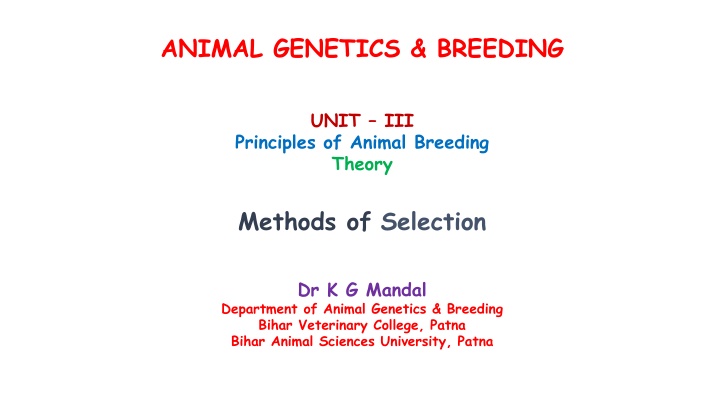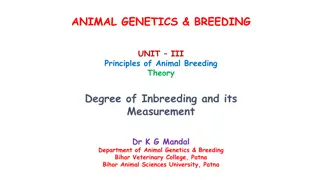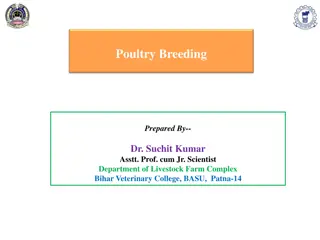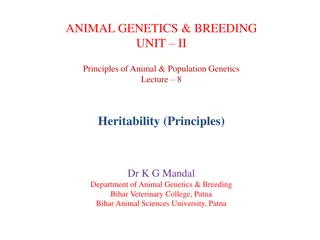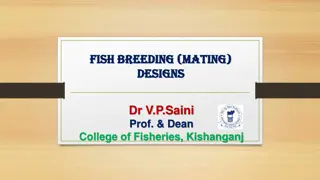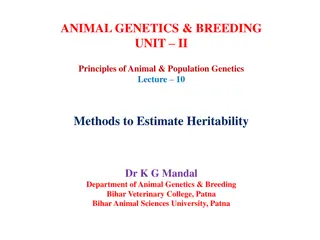Principles of Animal Breeding Theory and Methods of Selection
Animal breeding involves selecting for desirable traits to improve the overall merit of animals. Methods such as tandem selection and multi-trait selection are used to enhance genetic progress. Economic value, genetic significance, and selection criteria play important roles in the breeding process. Tandem selection focuses on improving one trait at a time over several generations, while multi-trait selection aims to enhance multiple traits simultaneously. Understanding genetic correlations is crucial for successful breeding programs.
Download Presentation

Please find below an Image/Link to download the presentation.
The content on the website is provided AS IS for your information and personal use only. It may not be sold, licensed, or shared on other websites without obtaining consent from the author.If you encounter any issues during the download, it is possible that the publisher has removed the file from their server.
You are allowed to download the files provided on this website for personal or commercial use, subject to the condition that they are used lawfully. All files are the property of their respective owners.
The content on the website is provided AS IS for your information and personal use only. It may not be sold, licensed, or shared on other websites without obtaining consent from the author.
E N D
Presentation Transcript
ANIMAL GENETICS & BREEDING UNIT III Principles of Animal Breeding Theory Methods ofSelection Dr K G Mandal Department of Animal Genetics & Breeding Bihar Veterinary College, Patna Bihar Animal Sciences University, Patna
Methods of Selection Introduction: The net economic value of an animal depends on performance of several characters. For example, a dairy cow will be more economical to maintain if she produces more milk (more LMY) with higher fat content in milk ( fat %) for a longer period of time (longer lactation length), remain dry for a shorter time between two successive calvings (shorter Calving Interval) etc. It is therefore , essential to estimate the total breeding worth i.e., net merit of an animal.
Multi trait selection: Selection is practiced for several traits simultaneously to improve the overall merit of the individuals. Requirement and efficiency of multi trait selection: i. Estimation of economic value of the traits. ii. Genetic significance of the animal in terms of h2 of the traits and genetic correlations among the traits. iii. The methods of selection and number of traits to be included in the selection criteria. Methods of Selection: 1. Tandem method 2. Independent Culling Level method 3. Selection Index or total score method
1. Tandem Method This is a multi trait selection. Tandem method is practiced for improvement of several traits but at different times i.e., one trait at a time and selection process will continue for several generations till the improvement is made in that trait up to desired level. Thereafter, selection is practiced for improvement in the second trait and the selection process will also continue for several generations till the goal is achieved to the desired level. In this way selection will continue for all the traits one by one.
If number of traits considered for selection is n , then the average genetic improvement in each of n independent and equally important traits per generation would be only 1/n times. The efficiency of this method depends on the genetic correlation among the traits under selection. Merit of Tandem method: This method is easy to understand and easy to conduct. If genetic correlation between the traits is positive then improvement in any one trait would lead improvement in the correlated traits.
Demerit of tandem method: This method is less efficient than other methods. The genetic progress per unit of time is less. It requires more time for improvement in all the traits. An undesirable genetic correlation between two traits would neutralize the genetic progress made in any one trait.
2. Independent Culling Level Method of Selection Two or more traits are taken at a time for selection of an individual. A minimum standard (level) is fixed for each and every trait. Each and every animal has to achieve the target fixed for each character for its selection. If an animal fails to meet the minimum standard fixed for any one character will be rejected even though it is exceptionally good for all other traits.
Example: IC L method of selection in buffalo Traits Standard Set Buffalo No. 1 40 1850 7 2 44 2200 6.5 AFC (months) LMY (Kg) Fat % 42 1800 7 Buffalo no. 2 is rejected though it is excellent in LMY. Buffalo no. 1 is selected as it has achieved the minimum target fixed for all the three traits.
Advantages of IC L: i. It is superior to tandem method because selection is practiced for more than one trait at a time. ii. Culling process may be started at the early age for the traits expressed at early age. Disadvantages: i. It is inferior to Selection index or total score method. ii. No compensation for superiority of an excellent trait. iii. More emphasis is given to the traits expressed at early life. iv. Intensity of selection is reduced with the increase in number of traits. v. Only mediocre animals are selected.
Efficiency of the method: It depends on standard (level) fixed for each character. If level fixed is low, very few animals are to be rejected. If standard kept at very high level, only few animals will have the opportunity to be selected. It is superior than the tandem method of selection. It is inferior to Selection index or total score method.
3. Selection Index Introduction: Selection index is the numerical score assigned to an individual to estimate its breeding value on the basis of economic weight of the traits considered for selection. Several number of traits are considered simultaneously for selection of an individual. Selection index is an index of the net merit of an animal for many traits. Deficiency in some traits is taken into account by superiority of other traits. Certain value (economic weight) is assigned to each trait depending its h2 and economic value as well as genetic correlation among the traits.
Values of all the traits are added together to get the total score for an animal. For this reason selection index is also known as total score method. Credits and penalties are given to each animal according to the degree of superiority or inferiority in each trait. The animal with the highest score is then selected for breeding. Some weightage is given to each trait due to their unequal economic importance and thus allows equal attention to each trait. The amount of weightage given to each trait in relation to other traits determines the influence of each trait on the final index. The amount of weightage depends upon the economic weight and genetic significance of the traits.
Selection index is the sum of the product of phenotypic value with the respective economic weight of different characters incorporated into the index. Thus, selection index, I = bixi = b1.x1 + b2.x2 + b3.x3 + .. + bn.xn Where, xi (x1, x2, x3 ..xn) represents the phenotypic values for different traits and bi are the weighting factors (partial regression coefficient) given to each trait. Selection index was developed by Prof. R A Fisher in 1936 and first used for genetic improvement in animals by Hazel in 1943.
Merit of selection index: i. It is superior than the tandem and ICL methods. ii. It overcomes the disadvantages shown by tandem and ICL. iii. Selection on the basis of an index is a more balanced approach since it combines information of various traits on the basis of their economic importance. iv. It allows individuals which are superior in some traits to be selected regardless of their inferiority in other traits. v. Efficiency of S.I. increases with the increase in the number of traits to be selected but the response in the individual traits become less. vi. Hence, only those traits considered more important should be included into the index.
Requirements in the construction of S.I.: i. Economic value or relative economic importance of each of the trait. ii. Genetic and phenotypic variances of all the traits. iii. Genetic and phenotypic covariance among all the traits.
